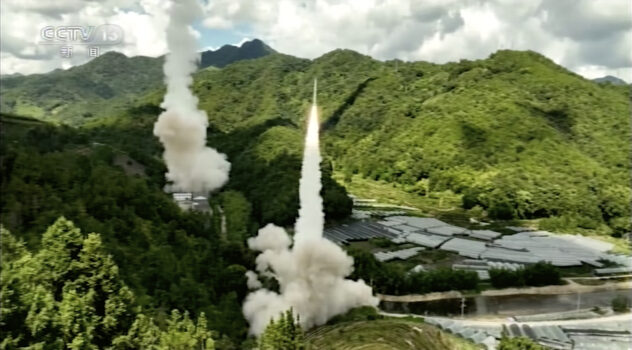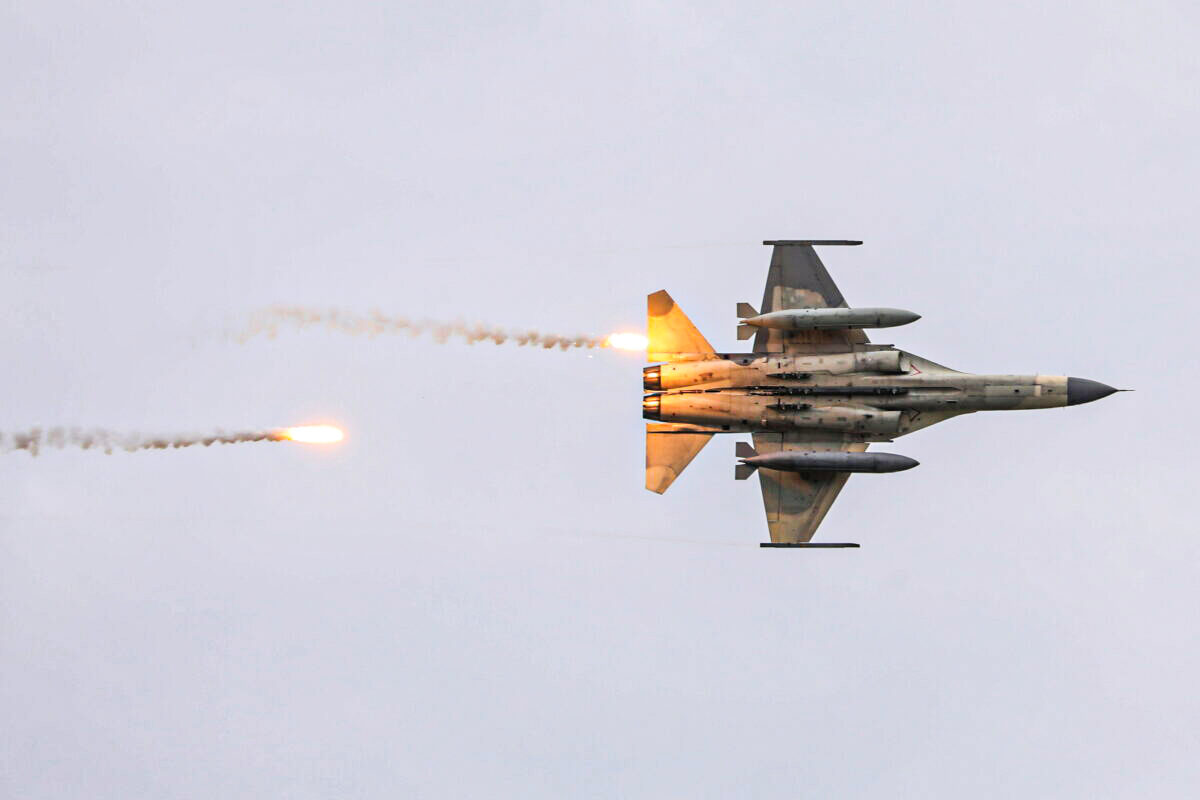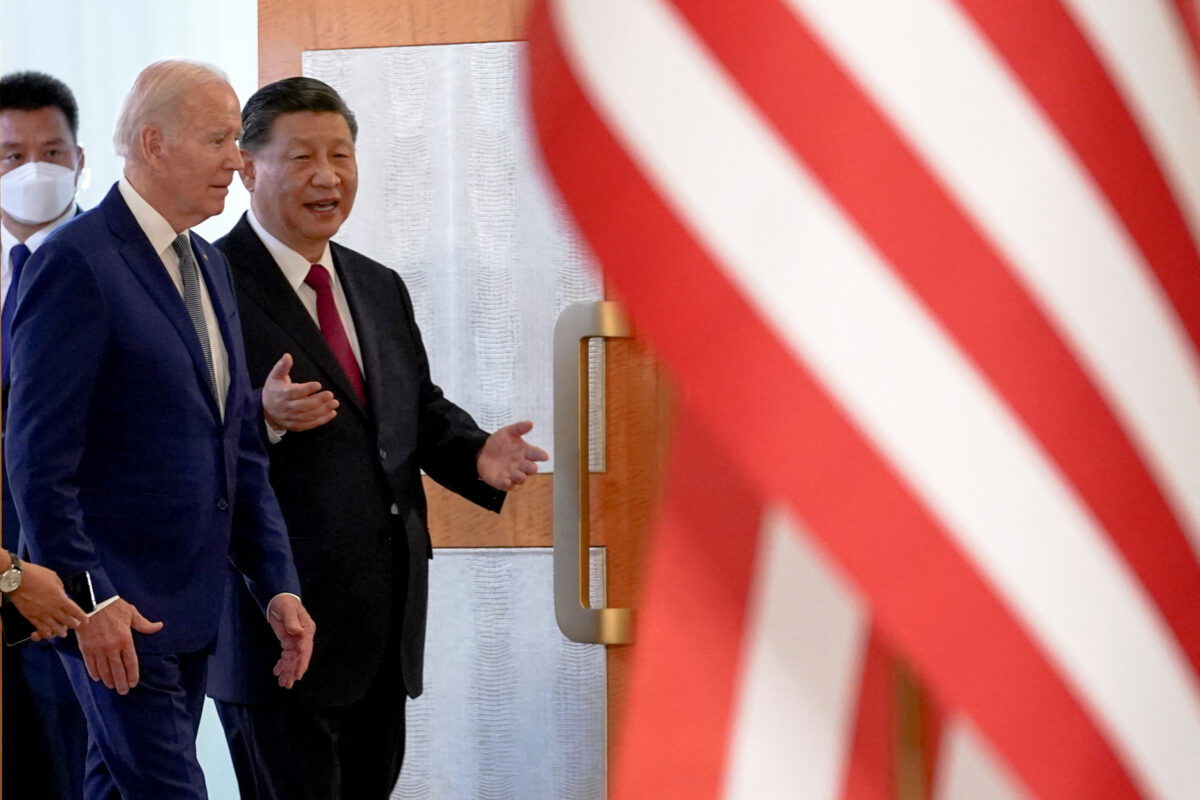On a crisp sunny day in October, Chinese Communist Party (CCP) leader Xi Jinping appeared in full military fatigues at a command center in eastern China and ordered the regime’s military wing to prepare for any war.
Though such bellicosity has become something of the norm in Chinese communist diplomacy, the looming threat of an invasion of Taiwan and a much anticipated meeting with U.S. President Joe Biden rendered the words more potent.
Indeed, just days later, Xi met with Biden in Indonesia. Shortly after the talk, Biden said that there was no need for a new Cold War and that the United States would pursue peace and stability with China in the Taiwan Strait.
The CCP issued a statement of its own mere hours later, quoting Xi.
Cross-Strait peace and stability and Taiwan independence are as irreconcilable as water and fire, Xi said, according to state-owned propaganda outlet Global Times.

It was just the latest statement from the CCP threatening the lives of so-called “separatist” forces in Taiwan, a label that Xi and his regime apply to the president of Taiwan and virtually all of the island’s democratically-elected government.
The rhetoric of war emanating from the communist regime at every turn as of late has been equally matched by its military development. Now, a growing number of experts believe that a CCP invasion of Taiwan is not only likely, but inevitable, and that such a war would be just one step on the path to supplanting the United States from its position as leader of the global order.
James Fanell, a government fellow at the Geneva Centre for Security Policy in Switzerland and former director of intelligence and information operations for the U.S. Pacific Fleet, explained that the CCP is playing a long game.
“Due to the continuing guidance of the past three leaders of the Chinese Communist Party, the PRC has been on a 20-plus year military modernization program,” Fanell said, using an acronym for the official name of communist China, the People’s Republic of China.
The CCP’s military wing, the People’s Liberation Army (PLA), had a two-pronged goal, he said: To seize Taiwan, and topple America from its place of prominence on the global stage.
“This ongoing PLA modernization program is aimed at supporting the CCP’s strategic ambition to displace the United States from the Indo-Pacific, and to ultimately restore the PRC to what they believe is China’s rightful position as the leader of the world,” Fanell said.
“Today that entails leading the global order across all levers of national power, especially in the military domain, both conventional and nuclear.”
Speaking on the subject of conventional military buildup earlier in the year, Dakota Wood, a senior research fellow at The Heritage Foundation, a conservative think tank, said that China’s military now numerically dwarfed that of the United States in almost every area of measurement, and that the CCP would have the advantage of numerous land, air, and sea-based systems in any conflict.
“Numerically, it’s very concerning,” Wood said during an Oct. 18 interview with NTD, a sister media outlet of The Epoch Times. “As an example, we’ve got fewer than 300 ships in the U.S. Navy. Of those, 100 are at sea on any day. Of that 100, about 60 are in the western Pacific.”
“The Chinese navy alone is 360 ships,” Wood added. “So, just in numbers, even if our ships are far better than theirs, it’s still a 6-to-1 disadvantage.”
Fannell said that this numeral superiority was the result of an effort decades in the making and spanning numerous CCP leaders.
“The initial focus of the PRC’s military modernization program beginning in the early 2000s was largely focused on asymmetric weapons, like anti-ship cruise and ballistic missiles,” Fanell said.
Such investments, Fanell said, initially helped to build out the regime’s “counter-intervention” strategy. More commonly referred to as “anti-access/area-denial” in the West, the counter-intervention strategy was designed to block U.S. forces from engaging in the Indo-Pacific, thereby ensuring no Western intervention was possible for a CCP invasion of Taiwan or the forced acquisition of other claimed territories in the South and East China Seas.
“For the next 20 years the PRC’s Central Military Commission prioritized the build-up of its Navy to provide the PLA an overmatch of anti-access and area-denial forces,” Fanell said, referring to the regime’s top military body.
“During that time we saw the initial focus on the build-up of the PLA Navy’s submarine forces and over the past decade that focus shifted into mass production of frigates, destroyers, cruisers, and large deck amphibious warships. The culmination of the naval modernization program was epitomized by the fielding of three aircraft carriers.”
These new vessels and armaments are thus serving to transition the CCP’s navy from mere numerical superiority to a qualitative advantage as well, capable not only of preventing the United States from effectively deterring conflict, but also of overcoming American forces in open battle with next-generation weapons.
According to Fanell, that development has not been limited to China’s navy, but also extends to its ground and air forces.
The CCP’s conventional military development is far from the most concerning part of its quest for hard power, however, and only scratches the surface of what the regime hopes to accomplish through military might.
“In the past two years we have seen the CMC [Central Military Commission] shift focus again to a new generation of asymmetric weapons such as hypersonic missiles and swarming unmanned systems from the sea, air, and land,” Fanell said.
“Most importantly, CCP leaders have embarked on what may be the most threatening weapons development to date: the massive build up of the PRC’s nuclear arsenal,” Fanell said.
The CCP has steadily worked to expand and modernize its nuclear arsenal across the triad of land, sea, and air capabilities and the discovery of over a hundred new missile silos in the deserts of western China in the past two years did little to quell fears of a new bid by the communist power to double down on nuclear terror.
The vast expansion of the regime’s nuclear arsenal, which the Pentagon anticipates will reach 1,000 weapons by 2030, is not the only problem for the United States, however. Indeed, the drastic improvement in the quality of technology of China’s weapons may be an even larger threat.
The regime’s new hypersonic and intercontinental ballistic missiles (ICBMs), such as the CCP’s Dongfeng-41 (DF-41), boast multiple independently targetable reentry vehicle (MIRV) systems. These systems allow each missile to be armed with multiple warheads (10 in the case of the DF-41), each of which can strike out at its own target while the missile is in orbit.
Thus, each of the CCP’s 1,000 new nuclear weapons could boast as many as 10 nuclear warheads. As such, if the CCP has already built enough DF-41s to stock all of its newly constructed silos, it could have increased its nuclear warhead stockpile fourteen times over.
“In the space of 24 months the PLA Rocket Forces built 350 new ICBM silos in Central and Western China,” Fanell said. “These new silos are assessed to support the DF-41 ICBM.”
“With each missile having ten multiple independently targetable reentry vehicles, this development has increased the PRC’s nuclear arsenal from some 250 warheads to over 3,500.”
Much to the chagrin of Western analysts, however, it is impossible to say with certainty how many nuclear weapons or warheads the regime actually has in its possession, as the CCP co-locates its nuclear and conventional missiles so that prying eyes can never be certain if a silo is housing a regular missile or a nuclear one.
The situation led Adm. Charles Richard, Commander of the U.S. Strategic Command, to assert that the regime was engaged in a ‘strategic breakout’ that would enable it to meet and then exceed the United States’ own capabilities.
“As I assess our level of deterrence against China, the ship is slowly sinking,” Richard said during a speech earlier this year.
“It is sinking slowly, but it is sinking, as fundamentally they are putting capability in the field faster than we are.”
“This ‘strategic breakout’ portends to shift the PRC’s so-called ‘no first use’ policy to one of ‘first use’ where Beijing can threaten nuclear blackmail against the U.S. and its allies from coming to Taiwan’s defense,” Fanell said.
“This change is by far the most destabilizing PRC military modernization to date, one that will directly affect Taiwan’s freedom, regional stability in the Indo-Pacific, and even shift the global balance of power in the near and long term.”
To that end, the CCP has consistently refused to partake in talks aimed at nuclear non-proliferation and, according to the U.S. defense strategy, is explicitly expanding and modernizing its own nuclear arsenal with the purpose of threatening the United States.
Likewise, the CCP’s ambition to create a multipolar world with itself at the center of world events is central to its core strategic goal of displacing the United States. Thus, while the United States seeks solutions to diplomatic and military quandaries that will maintain the status quo, the CCP has no intention of doing anything of the sort. The regime’s goal is to destroy the status quo, not to preserve it.
Air Force Secretary Frank Kendall addressed this very subject during a talk in September.
“One of the most significant changes has been the nuclear breakout of China,” Kendall said.
“The only nation-state that [now] has the capacity, the resources, and the strategic intent to really threaten the United States as a leader in the world … is China.”

To answer the question of why all this newfound bombast? Why the shiny new military and nuclear weapons? The answer appears simple enough: The CCP intends to use overwhelming force in the near future and, by most accounts, its first target will be Taiwan.
The CCP claims that Taiwan is a rogue province of China that must be united with the mainland, and refuses to rule out the use of force to achieve this goal. Its leadership has indeed explicitly threatened war on the issue numerous times.
Taiwan has never been controlled by the CCP, however. The island nation has been self-governed since 1949 and boasts a thriving democratic government and market economy.
Washington, meanwhile, diplomatically recognizes China but does not endorse the CCP’s claims over Taiwan, while also maintaining economic and legal ties with Taipei which bind it to provide the arms necessary for the island’s defense.
Much of the worry among Western analysts and strategists have thus focused on how the United States and its allies can deter an ever-expanding PLA from gobbling up Taiwan.
But some believe that the invasion cannot be prevented, only fought.
Retired Air Force Brig. Gen. Robert Spalding said that the tension over the situation between the CCP, Taiwan, and the United States would end in conflict, and that it was too late to deter such an outcome.
“The situation will be resolved,” Spalding said. “It will be resolved when the Chinese invade Taiwan. There is no way to deter it.”
“The resolution is the invasion and the invasion will come at the time of China’s choosing. There’s nothing we can do at this point to stop it.”
To that end, Spalding said that the CCP’s military and foreign policy toward the United States was clearly oriented to push Washington away from entering such a conflict in the defense of Taiwan. Regardless of the outcome, Spalding said, such a war would in global catastrophe and, perhaps, nuclear war.
Regardless, the regime was committed to destroying Taiwan’s democratic way of life with force, according to Spalding, also a contributor to The Epoch Times. CCP leadership was smart enough to understand that the free Taiwanese people would never voluntarily unite with communist China.
“They’re not going to abandon their military force when it comes to taking Taiwan,” he said.
“They think that that’s the only way to get reunification.”
And the regime is likely right in that regard, Spalding said. Taiwan is Asia’s most thriving democracy with a world-class market economy and a populace that enjoys broad civil and political freedoms.
“There’s no way that they’re going to convince the Taiwanese people through peaceful means to join China after what they did to Hong Kong,” he said, referring to Beijing’s brutal suppression of the Asian financial hub.
“There is no way that the Taiwanese population is going to want to come under the yoke of the Chinese Communist Party,” he added.
“Everybody’s eyes are wide open. The only question to ask is when is that invasion going to come?”

On the issue of Taiwan and the inevitability of catastrophic conflict, Fanell offered a more hopeful stance, believing that the deterrence of such a war was still possible, though requiring immediate and vigorous action from the United States.
“In order to take on this threat, the United States must first acknowledge that the threat is existential and one that it must dominate the ‘whole of government’ agenda regardless of which political party is in power,” Fanell said.
“As it relates to the military realm, the U.S. must reprioritize its national security strategy away from one of cooperation and competition with the PRC to one of a war footing against the CCP, which is in a Cold War with the U.S.”
To that end, Fanell called on Congress to pass a bill to expand the U.S. Navy to at least 355 combat vessels in the same kind of massive increase achieved by legislation in 1940, when the United States expanded its maritime power to defeat the Imperial Japanese Navy in World War II.
Similarly, he said, the United States would need to further arm Taiwan, Japan, and its other allies with weapons capable of sinking PLA fleets. While many such sales had already been approved by Congress, he noted, bureaucratic red tape and regulations were slowing the flow of weapons to the point that orders placed by Taiwan now would not reach the island for years to come in some cases.
“The bureaucratic red tape must be set aside and the munitions must begin to flow, even in this year,” Fanell said.
Ultimately, Fanell said, the CCP was in a war with the United States, albeit a cold one. And the United States would have no hope of winning that war or preventing a global conflict if it did not admit such a new cold war existed.
Only through its own expansion and modernization, Fanell said, could the United States hope to remain in its place as leader of the free world.
“Ultimately, the U.S. must build up both conventional and nuclear force posture, along with a combined command and control structure for those forces,” Fanell said.
“[Such is necessary] in order to force CCP leaders back to the ‘drawing board’ to reconsider the success of any attempt to invade Taiwan or conduct any other such act of military expansionism.”